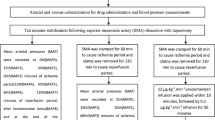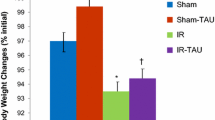Abstract
Pituitary adenylate cyclase-activating polypeptide (PACAP) is present in the gastrointestinal tract and plays a central role in the intestinal physiology, mainly in the secretion and motility. The aim of our study was to compare the ischemic injury in wild-type and PACAP-38 knockout mice following warm mesenteric small bowel ischemia. Warm ischemia groups were designed with occlusion of superior mesenteric artery for 1, 3, and 6 h in wild-type (n = 10 in each group) and PACAP-38 knockout (n = 10 in each group) mice. Small bowel biopsies were collected after laparotomy (control) and at the end of the ischemia periods. To determine oxidative stress parameters, malondialdehyde (MDA), reduced glutathione (GSH), and superoxide dismutase (SOD) were measured. Tissue damage was analyzed by qualitative and quantitative methods on hematoxylin/eosin-stained sections. In PACAP-38 knockout animals, tissue MDA increased significantly after 3 and 6 h ischemia (133.97 ± 6,2; 141.86 ± 5,8) compared to sham-operated (100.92 ± 3,6) and compared to wild-type results (112.8 ± 2,1; 118.4 ± 1.03 μmol/g, p < 0.05). Meanwhile, tissue concentration of GSH and activity of SOD decreased significantly in knockout mice compared to wild-type form (GSH, 795.97 ± 10.4; 665.1 ± 8,8 vs. 893.23 ± μmol/g; SOD, 94.4 ± 1.4; 81.2 ± 3.9 vs. 208.09 ± 3,7 IU/g). Qualitative and quantitative histological results showed destruction of the mucous, submucous layers, and crypts in knockout mice compared to wild-type tissues. These processes correlated with the warm ischemia periods. Our present results propose an important protective effect of endogenous PACAP-38 against intestinal warm ischemia, which provides basis for further investigation to elucidate the mechanism of this protective effect.





Similar content being viewed by others
References
Arranz A, Abad C, Juarranz Y et al (2008) Vasoactive intestinal peptide as a healing mediator in Crohn's disease. Neuroimmunomodulation 15:46–53
Atlasz T, Babai N, Kiss P et al (2007) Pituitary adenylate cyclase activating polypeptide is protective in bilateral carotid occlusion-induced retinal lesion in rats. Gen Comp Endocrinol 153:108–114
Atlasz T, Szabadfi K, Kiss P et al (2010) Evaluation of the protective effects of PACAP with cell-specific markers in ischemia-induced retinal degeneration. Brain Res Bull 81:497–504
Azuma YT, Hagi K, Shintani N et al (2008) PACAP provides colonic protection against dextran sodium sulfate induced colitis. J Cell Physiol 216:111–119
Botia B, Seyer D, Ravni A et al (2008) Proxiredoxin 2 is involved in the neuroprotective effects of PACAP in cultured cerebellar granule neurons. J Mol Neurosci 36:61–72
Bray TM, Taylor CG (1993) Tissue glutathione, nutrition and oxidative stress. Can J Physiol Pharmacol 71:746–751
Carden DL, Granger DN (2000) Pathophysiology of ischemia-reperfusion injury. J Pathol 190:255–266
Cenedese A, Monneuse O, Gruner L et al (2009) Initial management of extensive mesenteric venous thrombosis: retrospective study of nine cases. World J Surg 33:2203–2208
Chen Y, Samal B, Hamelink CR et al (2006) Neuroprotection by endogenous and exogenous PACAP following stroke. Regul Pept 137:4–19
de la Lastra CA, Villegas I (2007) Resveratol as an antioxidant and pro-oxidant agent: mechanisms and clinical implications. Biochem Soc Trans 35:1156–1160
Ferencz A, Szanto Z, Borsiczky B et al (2002) The effects of preconditioning on the oxidative stress in small bowel autotransplantation. Surgery 132:877–884
Ferencz A, Racz B, Tamas A et al (2009a) Changes and effect of PACAP-38 on intestinal ischemia-reperfusion and autotransplantation. Transplant Proc 41:57–59
Ferencz A, Racz B, Tamas A et al (2009b) Influence of PACAP on oxidative stress and tissue injury following small bowel autotransplantation. J Mol Neurosci 37:168–176
Ferencz A, Reglodi D, Kalmar-Nagy K et al (2009c) Influence of pituitary adenylate cyclase-activating polypeptide on the activation of mitogen activated protein kinases following small bowel cold preservation. Transplant Proc 41:60–62
Gasz B, Racz B, Roth E et al (2006) Pituitary adenylate cyclase activating polypeptide protects cardiomyocytes against oxidative stress-induced apoptosis. Peptides 27:87–94
Gomariz RP, Juarranz Y, Abad C, Arranz A, Leceta J, Martinez C (2006) VIP-PACAP system in immunity. New insights for multitarget therapy. Ann N Y Acad Sci 1070:51–74
Guneli E, Cavdar Z, Islekel H et al (2007) Erythropoietin protects the intestine against ischemia/reperfusion injury in rats. Mol Med 13:509–517
Haglund U, Bergqvist D (1999) Intestinal ischemia—the basics. Langenbeck's Arch Surg 384:233–238
Hannibal J, Ekblad E, Mulder H, Sundler F, Fahrenkrug J (1998) Pituitary adenylate cyclase activating polypeptide (PACAP) in the gastrointestinal tract of the rat: distribution and effects of capsaicin or denervation. Cell Tissue Res 291:65–79
Hashimoto H, Shintani N, Tanaka K et al (2001) Altered psychomotor behaviors in mice lacking pituitary adenylate cyclase activating polypeptide (PACAP). Proc Natl Acad Sci USA 98:13355–13360
Minor T, Isselhard W (1998) Cellular signal level of cyclic AMP and functional integrity of the small bowel after ischemic preservation: an experimental pilot study in the rat. Eur Surg Res 30:144–148
Mittal A, Phillips ARJ, Loveday B, Windsor JA (2008) The potetntial role for xanthine oxidase inhibition in major intra-abdominal surgery. World J Surg 32:288–295
Mura M, Andrade CF, Han B et al (2007) Intestinal ischemia-reperfusion-induced acute lung injury and oncotic cell death in multiple organs. Shock 28:227–238
Nedvig K, Ferencz A, Roth E, Lorinczy D (2009) DSC examination of intestinal tissue following warm ischemia and reperfusion injury. J Therm Anal Calorim 95:775–779
Nemetz N, Abad A, Lawson G et al (2008) Induction of colitis and rapid development of colorectal tumors in mice deficient in the neuropeptide PACAP. Int J Cancer 122:1803–1809
Ohtaki H, Nakamachi T, Dohi K, Shioda S (2008) Role of PACAP in ischemic neural death. J Mol Neurosci 36:16–25
Park PO, Haglund U, Bulkley GB, Falt K (1990) The sequence of development of intestinal tissue injury after strangulation ischemia and reperfusion. Surgery 107:574–580
Quaedackers JSLT, Beuk RJ, Bennet L et al (2000) An evaluation of methods for grading histologic injury following ischemia/reperfusion of the small bowel. Transplant Proc 32:1307–1310
Racz B, Gasz B, Borsiczky B et al (2007) Protective effects of pituitary adenylate cyclase activating polypeptide in endothelial cells against oxidative stress-induced apoptosis. Gen Comp Endocrinol 153:115–123
Racz B, Gasz B, Gallyas F Jr et al (2008) PKA-Bad-14-3-3 and Akt-Bad-14-3-3 signaling pathways are involved in the protective effects of PACAP against ischemia/reperfusion-induced cardiomyocyte apoptosis. Regul Pept 145:105–115
Reglodi D, Fabian Z, Tamas A et al (2004) Effects of PACAP on in vitro and in vivo neuronal cell death, platelet aggregation, and production of reactive oxygen radicals. Regul Pept 123:51–59
Riera M, Torras J, Cruzado JM et al (2001) The enhancement of endogenous cAMP with pituitary adenylate cyclase activating polypeptide protects rat kidney against ischemia through the modulation of inflammatory response. Transplantation 72:1217–1223
Shioda S, Ozawa H, Dohi K et al (1998) PACAP protects hippocampal neurons against apoptosis: involvement of JNK/SAPK signaling pathway. Ann N Y Acad Sci 865:111–117
Shioda S, Ohtaki H, Nakamachi T et al (2006) Pleiotropic functions of PACAP in the CNS: neuroprotection and neurodevelopment. Ann N Y Acad Sci 1070:550–560
Somogyvari-Vigh A, Reglodi D (2004) Pituitary adenylate cyclase activating polypeptide: a potential neuroprotective peptide-review. Curr Pharm Des 10:2861–2889
Szakaly P, Kiss P, Lubics A et al (2008) Effects of PACAP on survival and renal morphology in rats subjected to renal ischemia-reperfusion. J Mol Neurosci 36:89–96
Thiery C, Sempoux C, Danse E (2009) CT underestimation of ileo-colic ischemia: a case report with pathologic correlation. JBR-BTR 92:213–217
Tunc T, Uysal B, Atabek C et al (2009) Erdosteine and ebselen as useful agents in intestinal ischemia/reperfusion injury. J Surg Res 155:210–216
Vaudry D, Pamantung TF, Basille M et al (2002) PACAP protects cerebellar granule neurons against oxidative stress-induced apoptosis. Eur J NeuroSci 15:1451–1460
Vaudry D, Falluel-Morel A, Bourgault S et al (2009) Pituitary adenylate cyclase-activating polypeptide and its receptors: 20 years after the discovery. Pharmacol Rev 61:283–357
Yan SF, Ogawa S, Stern DM, Pinsky DJ (1997) Hypoxia-induced modulation of endothelial cell properties: regulation of barrier function and expression on interleukin-6. Kidney Int 51:419–425
Ypsilantis P, Lambropoulou M, Tentes I, Kortsaris A, Papadopoulos N, Simopoulos C (2006) Mesna protects intestinal mucosa from ischemia/reperfusion injury. J Surg Res 134:278–284
Acknowledgements
This study was supported by Hungarian Scientific Research Fund (Grant OTKA PD77474, K72592, K73044, and CNK78480), ETT278-04/2009, Bolyai Scholarship of the Hungarian Academy of Sciences, and Grants-in-Aid for Scientific Research from Japan Society for the Promotion of Science.
Author information
Authors and Affiliations
Corresponding author
Rights and permissions
About this article
Cite this article
Ferencz, A., Kiss, P., Weber, G. et al. Comparison of Intestinal Warm Ischemic Injury in PACAP Knockout and Wild-Type Mice. J Mol Neurosci 42, 435–442 (2010). https://doi.org/10.1007/s12031-010-9357-6
Received:
Accepted:
Published:
Issue Date:
DOI: https://doi.org/10.1007/s12031-010-9357-6




